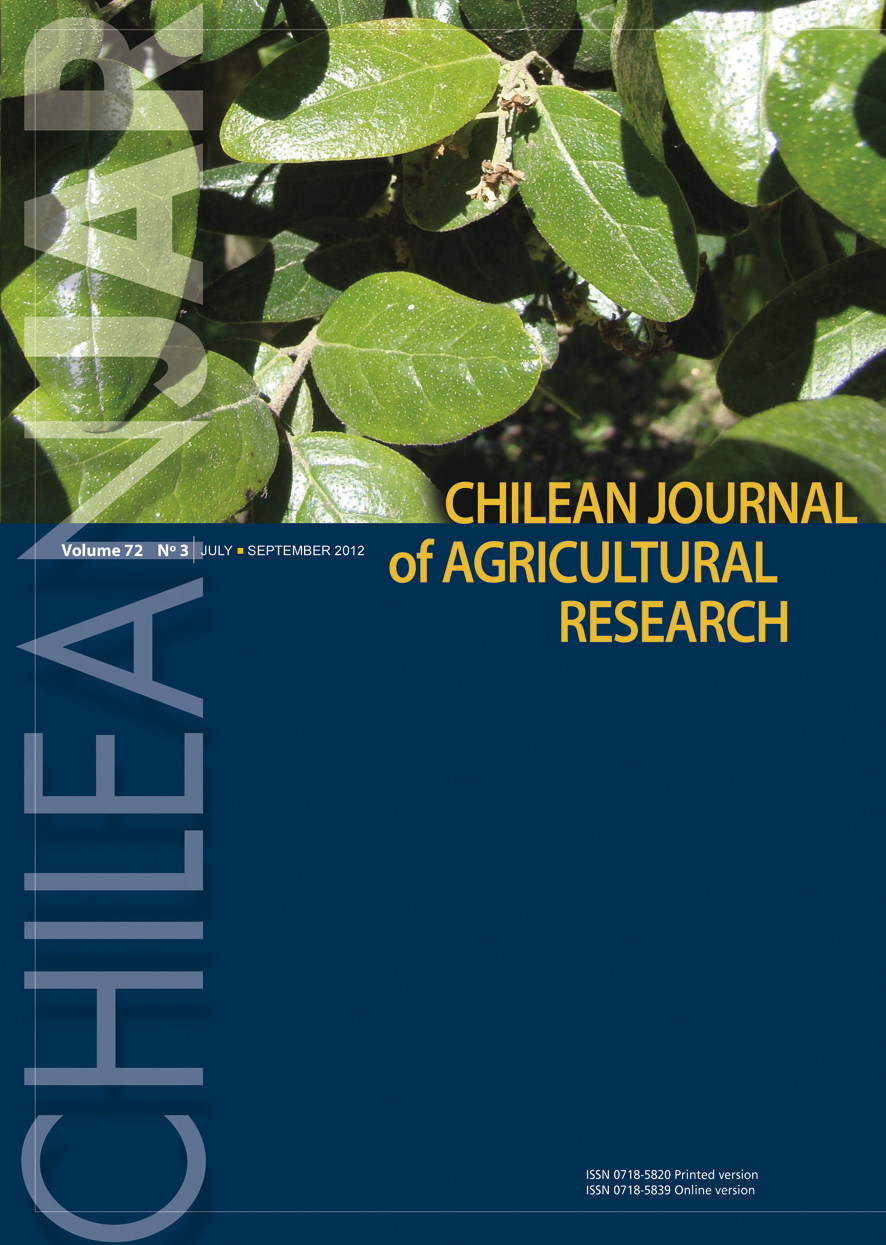
|
Chilean Journal of Agricultural Research
Instituto de Investigaciones Agropecuarias, INIA
ISSN: 0718-5820
EISSN: 0718-5820
Vol. 71, No. 1, 2011, pp. 3-15
|
 Bioline Code: cj11001
Bioline Code: cj11001
Full paper language: English
Document type: Research Article
Document available free of charge
|
|
|
Chilean Journal of Agricultural Research, Vol. 71, No. 1, 2011, pp. 3-15
| en |
Genetic Relationships of Common Bean ( Phaseolus vulgaris  L.) Race Chile with Wild Andean and Mesoamerican Germplasm L.) Race Chile with Wild Andean and Mesoamerican Germplasm
Becerra V., Viviana; Paredes C., Mario & Debouck, Daniel
Abstract
The Chilean common bean (Phaseolus vulgaris L.) belongs to the cultivated race Chile and its origin is presumably Andean. The objective of this study was to identify the origin of a group of Chilean accessions based on their genetic relationship with wild material from the Mesoamerican and Andean common bean gene pool. To achieve this objective, universal primers of chloroplast DNA (cpDNA) and mitochondrial DNA (mtDNA) were used to detect polymorphism using Polymerase Chain Reaction - Restriction Fragment Length Polymorphism (PCR-RFLP). Thirty-two genotypes were analyzed, including wild material from Mexico, Ecuador, Peru, Bolivia, and Argentina, as well as Chilean cultivated genotypes belonging to endemic Chilean accession types (Tórtola, Coscorrón, and Cuyano) and naturalized commercial lines (Frutilla, Bayo, Manteca, and Blanco grande). Results showed a low level of polymorphism for cpDNA (23%) and mtDNA (24%) in wild and cultivated Chilean common bean accessions. Some universal primers and restriction enzyme combinations were more efficient than others in detecting polymorphism. The Chilean materials were closely related to wild accessions collected in Argentina, Bolivia, and Peru indicating their Andean origin. The wild accessions from Ecuador were located in a intermediate position between the Mesoamerican and Andean accessions.
Keywords
Chilean common bean germplasm, chloroplast DNA, mitochondrial DNA, PCR-RFLP.
|
| |
| es |
Relaciones Genéticas entre el Germoplasma de Poroto ( Phaseolus vulgaris  L.) Raza Chile y Silvestres Andinos y Mesoamericanos. L.) Raza Chile y Silvestres Andinos y Mesoamericanos.
Becerra V., Viviana; Paredes C., Mario & Debouck, Daniel
Resumen
El poroto chileno (Phaseolus vulgaris L.) pertenece a la raza Chile, cuyo origen es desconocido y presumiblemente andino. El objetivo del trabajo fue identificar el origen de un grupo de genotipos chilenos basado en sus relaciones genéticas con material silvestre perteneciente a los acervos genéticos mesoamericano y andino. Para lograr este objetivo se usaron partidores universales de ADNcp y ADNmt con la metodología de la Reacción en Cadena de la Polimerasa-Fragmentos de Restricción Polimórficos. (PCR-RFLP). Se analizó un total de 32 genotipos de P. vulgaris, los cuales incluyeron materiales silvestres de México, Ecuador, Perú, Bolivia y Argentina y accesiones chilenas cultivadas pertenecientes a las principales clases comerciales chilenas (endémicas) como son: Tórtola, Coscorrón, Sapito, Cuyano y otras clases comerciales (naturalizadas) que se cultivan en el país como Frutilla, Bayo, Manteca, y Blanco Grande. Los resultados obtenidos indican la presencia un bajo nivel de polimorfísmo en ADNcp (23%) y en ADNmt (24%) en las accesiones silvestres y cultivadas chilenas. Algunas combinaciones de partidores-enzimas resultaron más eficientes que otras en detectar polimorfismo, lo mismo ocurrió con algunas enzimas específicas. Los materiales chilenos se presentaron estrechamente relacionados con las accesiones silvestres colectadas en Argentina, Bolivia y Perú indicando su origen andino. Las accesiones silvestres ecuatorianas se ubicaron en una posición intermedia entre las accesiones mesoamericanas y andinas analizadas.
Palabras-clave
germoplasma de poroto chileno común, ADN cloroplasto, ADN mitocondrial, PCR-RFLP.
|
| |
© Copyright 2010 Chilean Journal of Agricultural Research.
Alternative site location: http://www.inia.cl
|
|
